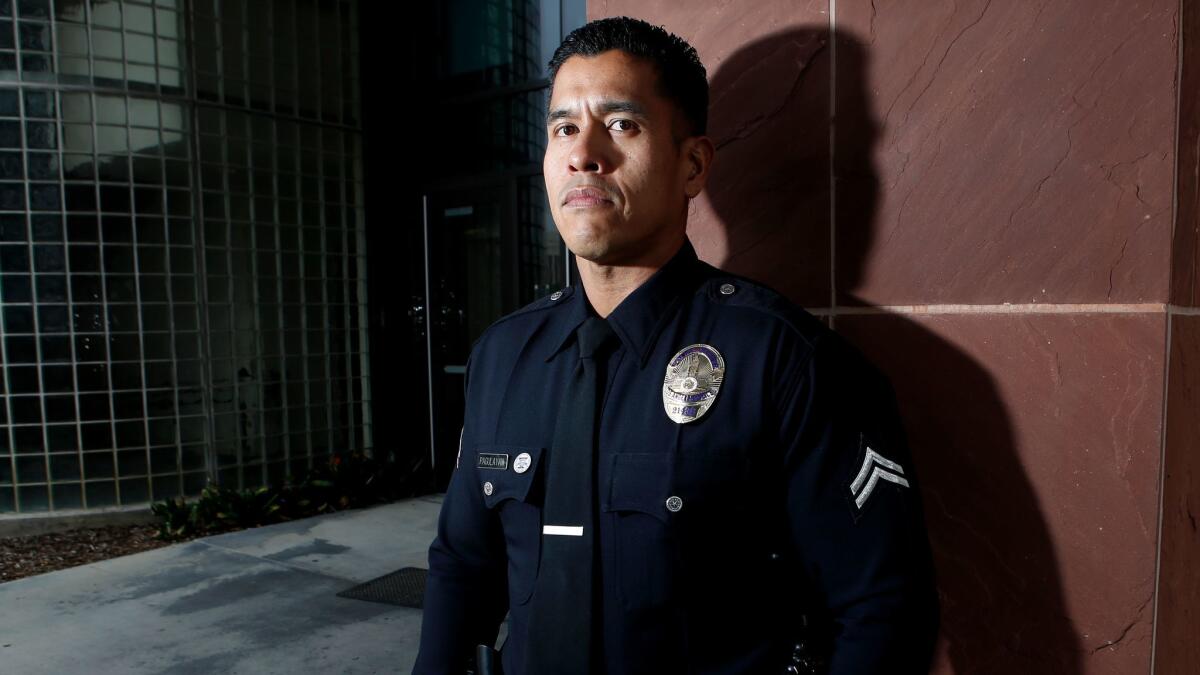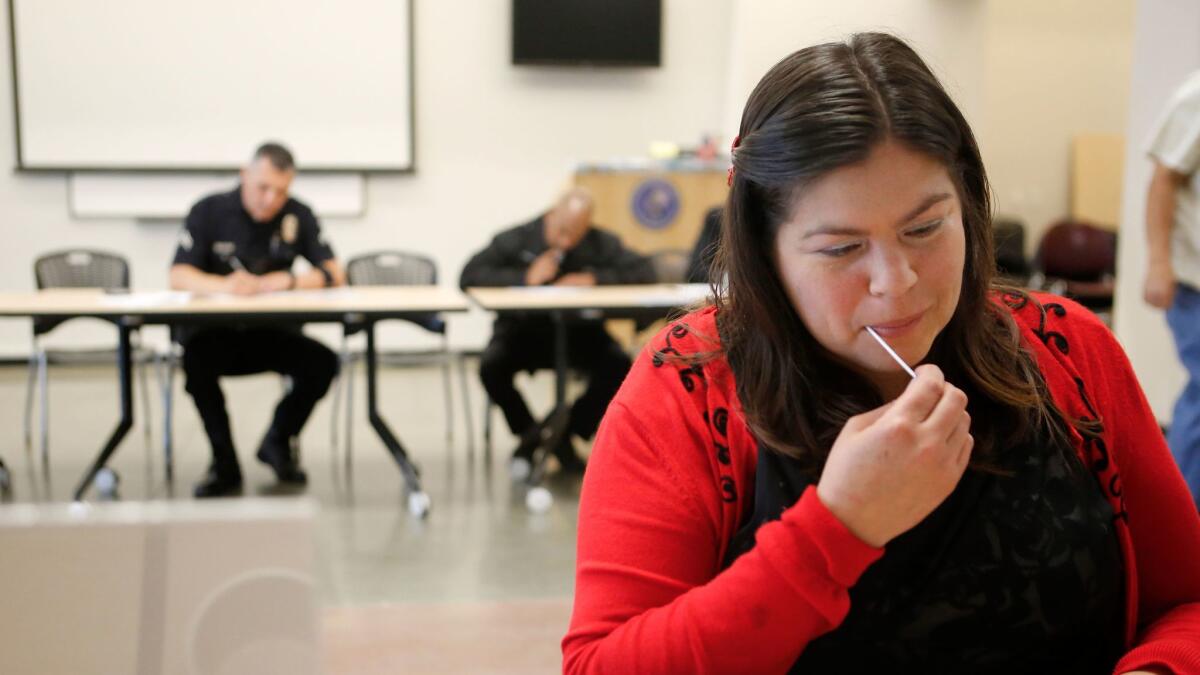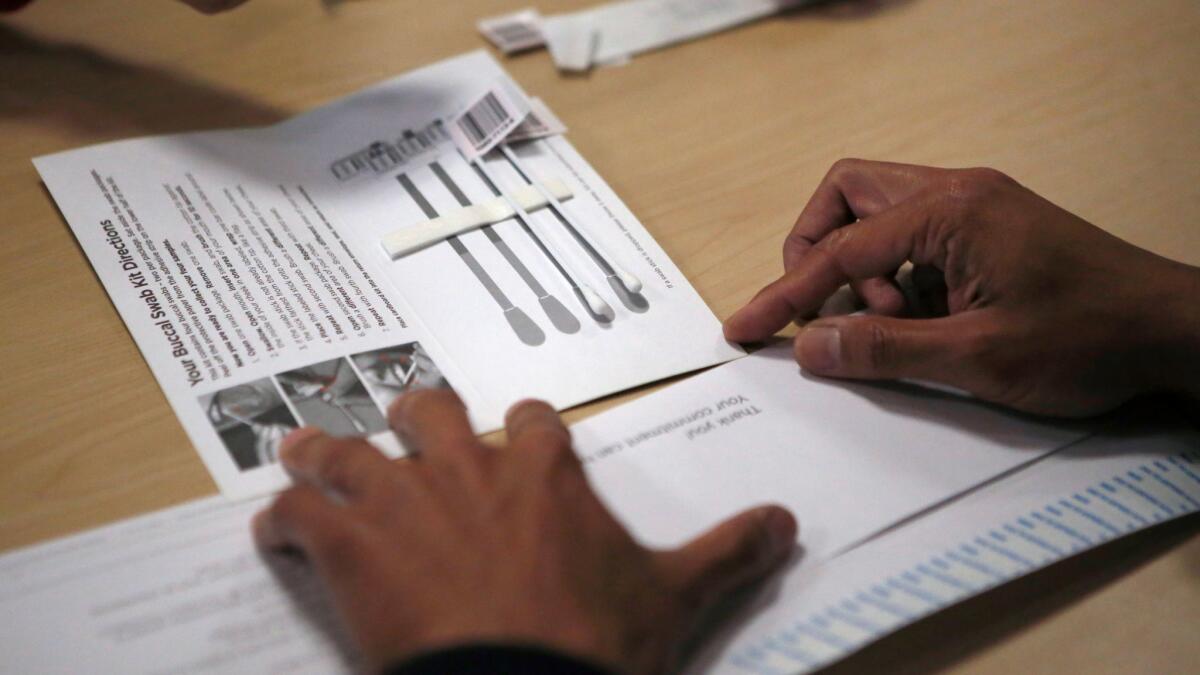An LAPD officer needs a bone marrow transplant. His ethnicity limits his chances of getting one
- Share via
Matthew Medina’s doctors diagnosed him with a rare blood disease a few months ago and told him he would probably die without a bone marrow transplant.
With that prognosis came another: The 40-year-old Los Angeles police officer had a less than 50% chance of finding a donor because he is not white.
Most successful matches for bone marrow transplants involve a donor and patient of the same ethnicity. But the majority of the 25 million registered donors nationwide are white, and Medina is Filipino. So far, no match has been found.
“You’re basically looking for a genetic twin,” said Athena Mari Asklipiadis, who runs Mixed Marrow, an L.A.-based organization that is trying to increase diversity in the bone marrow donor registry. “It’s not like we have more of a chance we would get a disease, or that we’re harder to match, it’s just that there’s not representation in the national registry.”
It’s a familiar problem for any nonwhite person who has needed a bone marrow transplant.
A white American of European descent has a 75% chance of finding a perfect match in the national donor registry, compared with a 40% chance for Filipinos. Few Filipinos in the U.S. have signed up as potential donors, and there is no registry in the Philippines.
Researchers are experimenting with ways to perform bone marrow transplants on people who can’t find matches. But while those treatments are being perfected, thousands of people are diagnosed every year with leukemia, lymphomas and other blood diseases whose only hope for a cure is a marrow transplant. And for them, it can come down to ethnicity.
Medina’s wife, Angelee, has watched dozens of people at sign-up events across Southern California, particularly in the Filipino community, volunteer to donate bone marrow with the hope of curing her husband. “We’re very thankful for that,” she said. “We’re hoping something comes up.”
For now, Medina is being kept alive with transfusions.
“All you want is for that loved one to have a chance,” said Officer Dante Pagulayan, Medina’s partner at the LAPD and a childhood friend. “That’s what we’re praying for.”
An unexplained illness
Medina went to the doctor in March because he had a rash. His blood work revealed something far more dangerous.
Medina was diagnosed with aplastic anemia, a disease in which the bone marrow stops working. Bone marrow is spongy material inside bones that produces the essential components of blood — white blood cells, red blood cells and platelets.
Between 600 and 900 Americans are diagnosed with aplastic anemia each year, according to the Aplastic Anemia and MDS International Foundation. The disease can be caused by exposure to toxic chemicals or a virus, but most cases, including Medina’s, are unexplained.
“One day he wakes up and the doctor tells him he has this. It could happen to anyone,” said Pagulayan, who went to high school and Cal State Long Beach with Medina and now works alongside him in the gang unit in the LAPD’s Harbor Division.
Blood transfusions can sustain Medina for now, but the only possible cure for aplastic anemia is a transplant, said Dr. Len Farol, a bone marrow transplant specialist at
Medina is quarantined at his home in Bellflower, where he lives with his wife and two young daughters. But he needs a transplant soon because his immune system is so weakened from his disease that exposure to a common virus could kill him, Farol said.

How ethnicity affects bone marrow matches
Doctors checked to see if Medina’s sister could be a match, but she wasn’t — siblings provide a match only about 25% of the time. They started combing through the registry, but trying to find a donor there can be like “finding a needle in a haystack,” Farol said.
Doctors look to see if the patient and potential donor share eight cell markers called human leukocyte antigens, or HLA. All eight have to match, but that’s rare because there are thousands of possibilities for each marker, experts say.
“There could be billions of combinations,” said Stephen Spellman, director of immunobiology and observational research for the Center for International Blood and Marrow Transplant Research. “Within any group, finding a match for HLA is difficult.”
Spellman said that people whose ancestors are from the same place tend to have the same markers because they evolved over time in response to different pathogens and diseases that were present in their environment.
According to a 2014 report in the New England Journal of Medicine, a person of white European descent has the highest chance of finding a perfect match — eight out of eight HLA markers — in the national registry of any ethnic group.
What's your chance of finding a perfect match? If you're...
- African American: 19%
- Hawaiian, Pacific Islander or Southeast Asian: 27%
- South Asian: 33%
- Hispanic South or Central American: 34%
- Japanese or Mexican: 37%
- Korean or Filipino: 40%
- Chinese: 41%
- Vietnamese: 42%
- Middle Eastern: 46%
- Native North American: 52%
- White European: 75%
Source: HLA Match Likelihoods for Hematopoietic Stem-Cell Grafts in the U.S. Registry, New England Journal of Medicine, 2014
Pagulayan, who is also Filipino, said neither he nor Medina knew ethnicity would affect his chances of being cured. Finding out that less than 1% of people in the registry were Filipino was “very disheartening,” he said.
There are international registries, but the vast majority of people worldwide who’ve signed up to donate bone marrow are from the U.S and Europe.
Plus, nonwhite populations in general tend to have more genetic diversity. African Americans, for example, have highly diverse genetics because of mixing with other groups since arriving in the United States, experts say. Filipinos are also very diverse because of the country’s long history of colonization.
Still, experts say that everyone who wants to help Medina should sign up for the registry, regardless of ethnicity.
Matches often break down along ethnic lines, but not always. Sometimes markers in one population also appear in another, or people don’t know their lineage.
Maya Chamberlin, who is half Indian and half white, had two bone marrow transplants after she was diagnosed with a rare blood disease called HLH in 2009 when she was 4.
Maya’s first donor was half Japanese and half Latino, and her second was half Japanese and half Filipino.
“So you never know how this works until you get on the registry,” said her mother, Mina Chamberlin, who lived in Torrance when Maya was diagnosed but has since relocated to Cincinnati to be closer to physicians who specialize in her daughter’s disease. “You just never know.”

Becoming a donor: ‘How often do we have that kind of opportunity?’
Angelee Medina canceled her family’s vacation to Mexico scheduled for this summer. She’d been commuting to a job as a graphic designer 20 miles from home when Matt was diagnosed, but found a closer place to work so she could take care of the kids and be near her husband.
“It was very, very overwhelming in the beginning,” she said. “With all the support we’re getting from everyone around us, it feels hopeful.”
More than 1,000 people have signed up to donate bone marrow over the past few months through dozens of drives for Medina, said Chris Chen, a recruitment coordinator for Little Tokyo-based nonprofit A3M, which focuses on getting more Asians to sign up for the Be the Match registry to donate bone marrow.
Potential donors submit cell samples by having the inside of their cheek swabbed. The cells are then analyzed to determine their HLA markers.
About 70% of transplants employ a process called peripheral blood stem cell donation, which is similar to a blood donation but can take several hours. In the other 30% of cases, donors are admitted to the hospital and anesthetized so doctors can remove marrow from their pelvic bone with a needle.
Ayumi Nagata, recruitment manager for A3M, knows that asking people to volunteer for a medical procedure they don’t need themselves can be a hard sell. But she tries to impress upon them how they could be the cure for someone’s cancer or other disease and save their life.
“How often do we have that kind of opportunity?” Nagata said.
The Medinas’ 8-year-old daughter, Cassiah, made a sticker that’s distributed at donor drives that says, “Keep calm and help our daddy fight!” When Angelee picked up Cassiah from day care recently, she found out that her daughter had been asking the other kids’ parents: “Did you get swabbed? Have you gotten swabbed yet?”
Doctors are testing ways to perform transplants on patients who can’t find a bone marrow match. Some are using umbilical cord blood, donated by mothers who’ve just given birth, which scientists say has a lower chance of rejection even if it’s not a complete match.
Haploidentical transplants, in which the donor and patient share only half of the eight markers, have also been successful in clinical trials, Spellman said.
Medina’s doctors think his best shot is still a perfect match for a bone marrow transplant, his wife said.
“That’s just what we’re waiting for,” she said. “I remind him one day soon, hopefully everything will be better.”

What to know about joining the bone marrow registry
- Doctors prefer donors between 18 and 44, but anyone up to 60 can sign up.
- Some medical conditions can make you ineligible to donate. Check them here.
- People who sign up for the registry can back out of the donation process at any time, but are encouraged to only sign up if they’re sure they want to donate.
- Approximately one out of 430 people who join the registry ends up donating their bone marrow.
- You can sign up for the registry online or find a drive near you here.
ALSO
Health officials urge meningitis vaccination amid L.A. Pride festival
You know CPR. Now firefighters want you to treat shooting and bombing victims
Sign up for Essential California
The most important California stories and recommendations in your inbox every morning.
You may occasionally receive promotional content from the Los Angeles Times.








